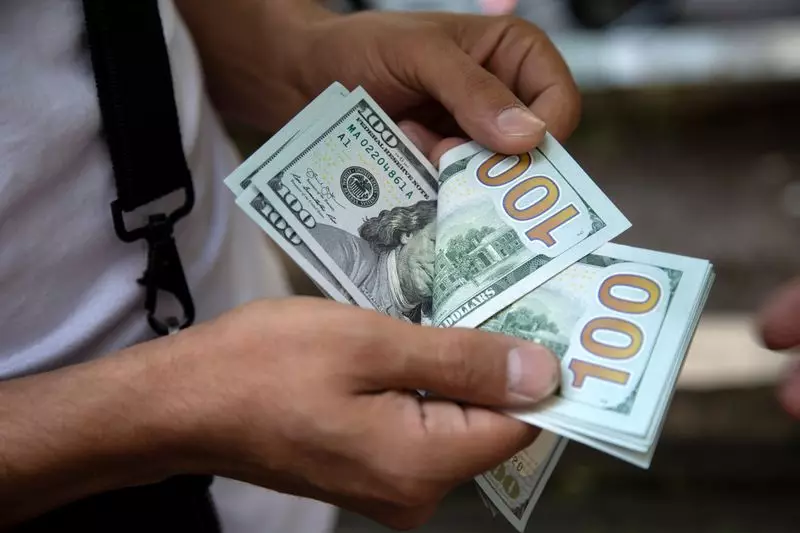The U.S. dollar’s recent upward trajectory highlights a significant phase in international finance, particularly as it relates to upcoming economic reports and central bank policies. As we dissect these movements, several factors come into play that reveals both the strength and vulnerabilities of the dollar, alongside a broader perspective on the global economy.
In recent weeks, the Dollar Index—a key indicator that measures the value of the U.S. dollar against a selection of six major foreign currencies—has shown notable resilience. As of early last Friday, the index gained 0.1%, landing at a value of 104.025, cementing a two percent increase overall from the previous month. This surge can be attributed to various macroeconomic factors, including fluctuations in inflation rates and substantial shifts in labor market data.
Understanding this momentum requires a deeper dive into inflation rates. The Federal Reserve’s primary gauge, the Personal Consumption Expenditures (PCE) index, indicated a year-over-year rise of 2.1% in September, dipping slightly from an upwardly revised 2.3% in August. This figure edges close to the Fed’s targeted 2.0%, setting the stage for discussions on monetary policy adjustments.
As we approach the release of the October jobs report, economists are bracing for significant changes in nonfarm payrolls, which are expected to decrease to approximately 106,000. This marks a sharp decline from the previous month’s robust figure of 254,000. The response of job seekers and labor conditions in the aftermath of recent natural disasters and labor strikes may inject volatility into these numbers, making them even less predictable.
Traders and analysts are also keenly aware of how these employment metrics will impact future Federal Reserve actions regarding interest rates. Currently, futures contracts indicate a 94.7% likelihood of a 25 basis point rate cut in the following week, heightening the anticipation surrounding the jobs report. Analysts from ING have suggested that if the job figures fall short of expectations, we could witness a bearish trend for the dollar as markets recalibrate expectations for Fed easing.
The political climate, particularly the looming presidential election, plays a critical role in currency fluctuations. Current trading behaviors suggest that the dollar may be benefitting from bullish outlooks towards Republican candidate Donald Trump. However, with Vice President Kamala Harris closely contesting, a potential victory for the Democrats could incite a major market reassessment. Traders could rush to unwind positions, amplifying immediate volatility across various currency pairs.
In Europe, the situation is fairly contrasting. The euro dipped marginally against the dollar, with EUR/USD trading at 1.0861. This decline followed reports of unexpected inflation spikes in the eurozone, raising concerns about the European Central Bank’s interest rate decisions. Having previously slashed rates three times in the current year, the ECB is widely speculated to pursue further cuts towards year-end. A fluctuating rate differential between the euro and dollar could facilitate the dollar’s dominance in the forex market.
Meanwhile, GBP/USD experienced a slight rise to 1.2917 as traders digest the recent UK budget which introduces extensive tax hikes. Analysts predict that the pound can experience further depreciation as markets adjust to a heightened bond supply, despite expectations that differing interest rate policies may provide a cushion for the currency.
In a parallel scenario, the USD/JPY pair gained 0.5% to reach 152.72. Despite the Bank of Japan’s commitment to maintaining ultra-low rates, comments from Governor Kazuo Ueda regarding decreased risks associated with the U.S. economy have prompted a nuanced reevaluation of the yen’s potential against the dollar.
In addition, the USD/CNY rate saw a minor increase, even as China’s manufacturing sector announced a rebound in growth, highlighting a resilient economic narrative amidst the ongoing global challenges.
The complexities of currency trading and economic indicators underline the U.S. dollar’s strength amid uncertain global economic conditions. Upcoming data, political scenarios, and ongoing developments in monetary policy will undoubtedly influence market trajectories. Investors should remain cautious, aware of the intricate interdependencies that exist within this dynamic landscape, as both domestic and global variables continue to shape economic trajectories in unpredictable ways.


Leave a Reply